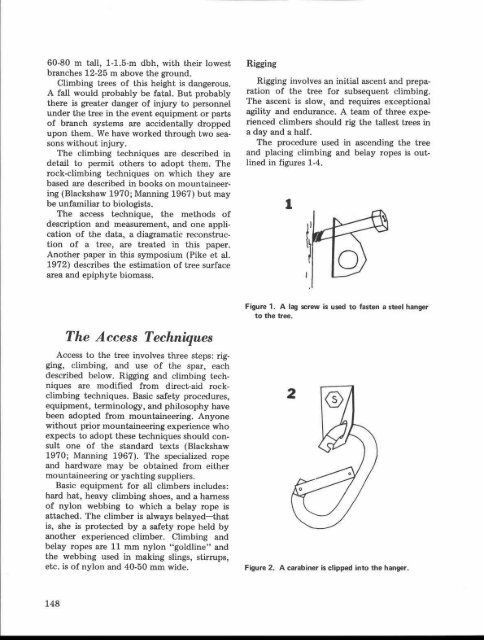PE EIE[R-Rg RESEARCH ON - HJ Andrews Experimental Forest
PE EIE[R-Rg RESEARCH ON - HJ Andrews Experimental Forest
PE EIE[R-Rg RESEARCH ON - HJ Andrews Experimental Forest
Create successful ePaper yourself
Turn your PDF publications into a flip-book with our unique Google optimized e-Paper software.
60-80 m tall, 1-1 .5-m dbh, with their lowest<br />
branches 12-25 m above the ground .<br />
Climbing trees of this height is dangerous .<br />
A fall would probably be fatal . But probably<br />
there is greater danger of injury to personnel<br />
under the tree in the event equipment or part s<br />
of branch systems are accidentally dropped<br />
upon them . We have worked through two sea -<br />
sons without injury .<br />
The climbing techniques are described in<br />
detail to permit others to adopt them . Th e<br />
rock-climbing techniques on which they are<br />
based are described in books on mountaineering<br />
(Blackshaw 1970 ; Manning 1967) but may<br />
be unfamiliar to biologists .<br />
The access technique, the methods o f<br />
description and measurement, and one application<br />
of the data, a diagramatic reconstruction<br />
of a tree, are treated in this paper .<br />
Another paper in this symposium (Pike et al .<br />
1972) describes the estimation of tree surfac e<br />
area and epiphyte biomass .<br />
Riggin g<br />
Rigging involves an initial ascent and preparation<br />
of the tree for subsequent climbing .<br />
The ascent is slow, and requires exceptiona l<br />
agility and endurance . A team of three experienced<br />
climbers should rig the tallest trees i n<br />
a day and a half .<br />
The procedure used in ascending the tre e<br />
and placing climbing and belay ropes is outlined<br />
in figures 1-4 .<br />
1<br />
Figure 1 . A lag screw is used to fasten a steel hanger<br />
to the tree .<br />
The Access Techniques<br />
Access to the tree involves three steps : rigging,<br />
climbing, and use of the spar, eac h<br />
described below. Rigging and climbing techniques<br />
are modified from direct-aid rock -<br />
climbing techniques . Basic safety procedures ,<br />
equipment, terminology, and philosophy hav e<br />
been adopted from mountaineering . Anyone<br />
without prior mountaineering experience who<br />
expects to adopt these techniques should consult<br />
one of the standard texts (Blackshaw<br />
1970; Manning 1967) . The specialized rope<br />
and hardware may be obtained from either<br />
mountaineering or yachting suppliers .<br />
Basic equipment for all climbers includes :<br />
hard hat, heavy climbing shoes, and a harnes s<br />
of nylon webbing to which a belay rope i s<br />
attached. The climber is always belayed-tha t<br />
is, she is protected by a safety rope held b y<br />
another experienced climber . Climbing an d<br />
belay ropes are 11 mm nylon "goldline" an d<br />
the webbing used in making slings, stirrups ,<br />
etc . is of nylon and 40-50 mm wide .<br />
Figure 2 . A carabiner is clipped into the hanger .<br />
148








